Adobe Photoshop Latest Version – Free Download For Mac & Windows and Review 2022

Photoshop Near Me: Photoshop is the best and most powerful image editor on the market. It has the tools to take a regular photograph and transform it into a work of art. Photoshop was the first editing software to work with layers which makes it much easier to work on large projects without worrying that any change might affect a different segment of the project.
There’s a whole host of tools that include changing backgrounds, adjusting facial features, creating 3D images, video editing, and much more. There is a learning curve to get the most out of most of the tools and features, but Adobe has an extensive collection of guides to help get the most of each tool.
Photoshop is a part of the Adobe Creative Cloud collection of apps, and therefore, it can seamlessly integrate with the other products, to allow you to combine multiple types of images, videos, and audio clips into your work.
While Photoshop is a premium tool, follow the instructions below and I’ll show you how to download your copy free for 7 days – and keep reading for my full review of Adobe Photoshop.
How to Download Photoshop For Free on PC
Adobe Photoshop Free Download

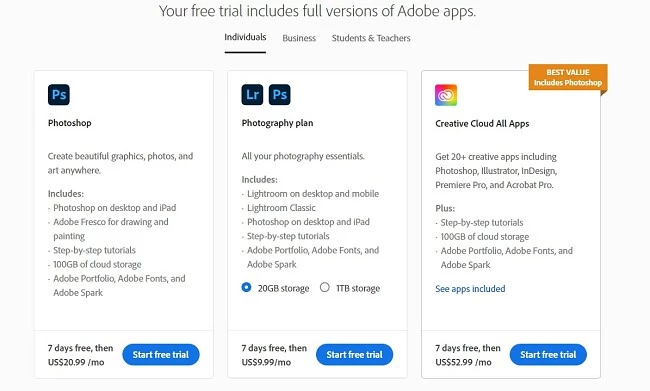
Photoshop: Includes apps for desktop and iPad, complete with 1000 GB of cloud storage,
- Photoshop and Lightroom: in addition to Photoshop, you’ll get Adobe’s Lightroom apps, which come with Adobe Portfolio, Fonts, and Spark.
- The entire Creative Cloud collection. Large collection of tutorials, 100GB of cloud-based storage, and access to Adobe software like Acrobat Pro, Dreamweaver, InDesign, XD, Premiere Pro, and much more.I’m downloading Photoshop for this example, but the process is the same for all three options. Then, click the Start Free Trial button.
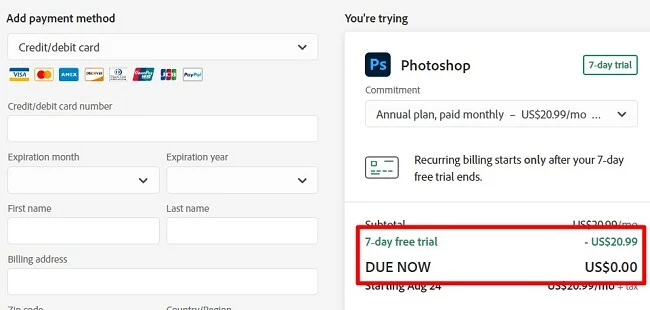
Photoshop Overview
Adobe Photoshop is a layer-based editing program. What this means is that for each action you take, a new layer is created. This makes it easier to edit the image and ensures that even if you make a mistake, it won’t ruin the entire project.
The program comes packed with tools that can adjust color tones, add texture, filters, text, hundreds of fonts, magic wands — the list just goes on and on.
There is no point in getting into a “how to use Photoshop” tutorial in this post, as there are entire books written on the subject. I will say that, for most questions you might have, YouTube will have some helpful videos that will help with basic editing and photo touch-ups.
Adobe Photoshop Features
This is a basic overview of some Photoshop features. I’ll get into more details in the Special Tools section below.
Working with Layers
Perhaps one of the most essential features of Photoshop is using layers to create your project. It not only gives you complete control over every aspect of your work but allows you to treat each object as an independent object.
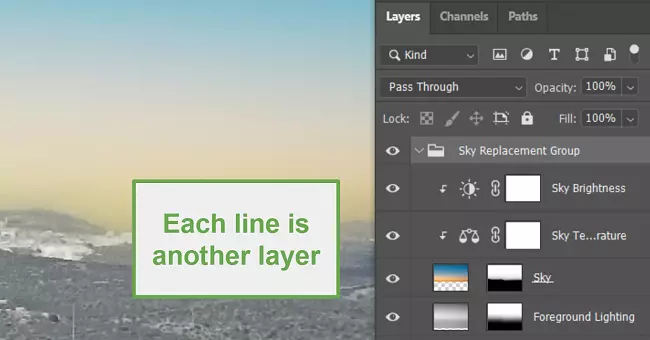
This means you can change colors, opacity, add borders, and easily move each object without affecting anything else on the page. Additionally, if you make a mistake, you only need to correct the one layer and not worry about the entire file.
Excellent collection of Selection tools
Photoshop has a group of tools known as Selection tools because they make it easy to select different objects that you want to edit. The main tools are the Lasso, Magnet Lasso, Polygonal Lasso, Magic Wand, Quick Mask, and Rectangular Marquee. Once you master these tools, you’ll be able to easily cut objects out of images, change colors, remove backgrounds, and more.
Improve Quality of Photographs
Photoshop has intuitive tools that make it easy to remove blemishes from pictures, including getting rid of red-eye, wrinkles, adjusting body shapes, changing the colors, cropping, trimming, sharpness, a wide selection of filters, and more.
Text Overlay
In addition to hundreds of font options and colors, Photoshop has many different text styles that allow you to insert the perfect vibe into your project. Some of the options include fisheye, bubble in, bubble out, bridge, reverse. Photoshop supports SVG OpenType fonts, which have become extremely popular with responsive designs that work for both computers and mobile devices, and recently added emoji fonts.
Video Editing
Photoshop has added a video editing element to its collection of features. The multitrack editing board allows you to merge multiple files, crop, trim, splice videos, add text overlay, and insert filter. You can also add an audio track, with the option to fade in and out, adjust the volume, and mute it.
Special Features and Tools
Neural Filters
Neural filters are one of the newest and most exciting additions to the software. It’s a workspace that makes it easy to change a person’s appearance by making them look older or younger, change their mood by turning a frown into a smile, or glaring eyes into happy ones. It uses AI machine learning, powered by Adobe Sensei, and generates new contextual pixels to alter the image.
Surprisingly, the filters are not that hard to use, and you can easily manipulate the images. The face tools use sliders, and you can adjust them to change happiness, anger, and surprise levels. However, if you go too extreme, the image will lose its natural look, so it’s a good idea to play around with the sliders until you get the proper expression and moods.
Many of the filters are still in Beta, which means that there is still room for improvement.

Improved Tools for Photographers
These days, Photoshop is known for its drawing tools, selection, and font tools – but when it first came out, Photoshop was for photographers. Adobe has gone back to its roots, so to speak, by upgrading its photo editing features. This includes support for raw camera files and excellent tools for correcting flaws and adding in natural effects.
You’ll have everything from basic selection tools that can add or remove objects to more advanced tools such as lens-profile-based geometry correction and histogram adjustments. Here are a few other new upgrades that can improve the quality and appearance of your pictures.
Change the Sky
It is a bit surprising that it took so long for Photoshop to add this feature. But now, instead of working with making tools and layers, you can turn that cloudy sky into a bright blue sky with a click of the button. There are also plenty of customization tools available so you can get your sky looking perfect.

Use AI to Fix Lens Blur
Photoshop has always had a blur tool, but it has been improved with AI. Now, the blur tool understands the color scheme in the pictures, which helps ensure that you won’t have an off-color blur. Another advantage is the tool gives you control over out-of-focus or blurry items in the background.
Expand your images
The content-aware crop tool is perfect for when you take a picture in portrait mode but need to display it in landscape mode. Often, the picture isn’t wide enough, and you’re left with extra white space on the sides. This tool will fill in the sides of your image with matching content. This works best with easy to duplicate patterns such as the sky, buildings, and the beach. Things that aren’t easily duplicated, like people, won’t look as good.
Adjust a person’s facial features
The Face-Aware Liquefy tool is similar to the Neural filters because it makes it easy to change the subject’s facial features and even the shape of the head. The biggest difference is that while Neural filters work with AI and add contextual pixels, Liquefy works with the pixels already in the image.

No more blurry pictures from shaky cameras
If you have a blurry picture, thanks to a shaky hand, or perhaps you snapped the shot while riding a roller coaster, Photoshop has a filter for you. Adobe has developed an intelligent mechanism that can detect the direction of your shaky picture, whether it’s horizontal, in an arc, going back and forth, or by rotating and realigning the pixels to sharpen your image and remove the blur.
Improve Font Match and Design
Photoshop has done many cool things with fonts over the years. Their latest updates will save you time and energy and allow you to maintain consistency with different documents. You can highlight the font you’re looking for, and Photoshop will give you the best matches.

If you open a file or documents with fonts that aren’t in your font library, Photoshop will run an automatic search online and install them for you.
If you have a font on a document, but you’re not sure which of the hundreds of fonts it is, the Font Match feature will identify the font for you.
A search function lets you filter fonts by classifications like Serif, Script, and Handwritten. Based on these attributes, you can see all similar fonts, choose your favorites, and preview any font by hovering over it with your mouse.
Multi-Track Video Editing
Photoshop has come a long from its early days as a photo editing software. One of the biggest improvements is the addition of video editing tools. Now you can add the same types of editing layers to videos that you can add to an image. Each video track is treated as a separate layer, allowing you to make changes or work on it separately from the other clips.
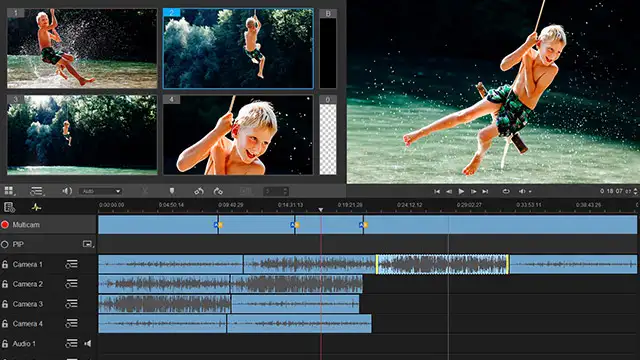
Photoshop has all the basic video editing tools so you can split, trim, splice, and merge multiple videos. You can also add an audio track, fade it in and out, adjust the volume, or mute it.
The editing options include fixing overexposed or underexposed videos, cropping, and adding a wide selection of filters. Photoshop also gives its users access to the same editing tools that are included in Adobe’s main video editing tool, Premiere Pro. This allows you to work on multiple tracks and apply keyframing.
The one area that is a bit lacking is the transition options between videos is a bit limited, with the only option being a variety of fades.
All movie or video files are saved as PSDs by default, but you can export them with H.264, QuickTime, or DPX encoding. There are also multiple resolution options, depending on where your video will be shown. These include 720p, 1080p, and 4K.
Export and Share Your Work
Photoshop now integrates with your operating system to streamline the exporting and share options. To get started; click on the Up Arrow located on the top right-hand corner of the window:

- Mac: Instantly export your projects to AirDrop
- Windows: Export the file to your email, My People, or any app that accepts photo files.
A Share option will also scale down the file size to fit the parameters for a quicker upload. You can upload directly to your preferred social media site or upload it to other Adobe apps where you can continue working on or completing your project.
Photoshop has many different ways of export options, including:
- Save the same file in multiple sizes
- Convert an existing design to sRGB, which is ideal for web display
- Add metadata, such as copyright information or a link back to your site, to protect your intellectual property
- Export a single Artboard or the entire project
- Use Quick Export to use your preferred format automatically
- Export files as PNG, JPG, GIF, or SVG
The Save for Web option is still available if you prefer the old ways of doing things, although the new style is faster and creates smaller files.
The Photoshop Interface
Photoshop improved its interface to make it more accessible for the average user with each new release. It has plenty of customizable options, including workspace options that are targeted for different editing styles. These include photography, painting, web-based images, videos and animations, and 3D. If you don’t see a workspace that fits your needs, you can always set up your own workstation with the panels, windows, and tools that you use frequently.

The interface can also recognize what type of work you are doing, automatically adjusting to fit your needs. For example, if you’re using a selection tool, such as the lasso or hand, or zoom, it will change the workstation to the Mask and Selection, which only shows tools that you can use while a selection tool is active.
Ease of Use
No one will confuse Photoshop with an easy-to-use editing program. However, there are some basic functions that even a novice can quickly pick up. Things like cropping, coloring, adding text, filters, and resizing are the same with most editing programs.
What makes Photoshop special is its collection of advanced tools that turn your photographs and paintings into works of art. The interface has undergone improvements, which does help the usability since it groups the tools by function, so you can quickly find what you’re looking for. There are also plenty of helpful tutorials, both on Photoshop and online, that will take you through the step-by-step process for using different functions and features. These include hanging background, removing blemishes, adjusting color balance, 3D rendering, working with smart objects, and much more.
While the learning curve is steep, and there is a lot to learn, once you’ve familiarized yourself with the tools, you’ll appreciate how intuitive the software is and how easy it is to use.
Getting Started
To start a new project, click on the New Document button on the top-left corner, and the dialog box will open. Now you can choose what type of template you want to work with, including options such as Textured Geometric Masks, Instant Film Mockups, and Photo Collage Layouts.
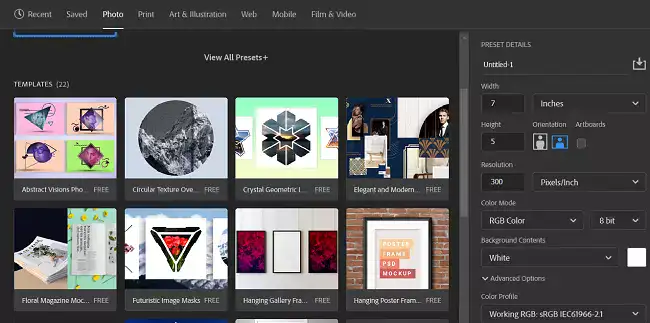
To make it easier to find the right template for you, adjust the filter to only show filters based on the category of your work. The available filters are:
If you’re unsure how a feature or tool works, you can click on the Home button, which will show you a list of all the tutorials, user guides, and a list of new features. Another option is to click the magnifying glass icon on the top-right corner of the page and utilize the search tool. In addition to finding objects, like your images, Adobe stock photos, and files, you can also search for “how-to” guides.
Adobe Photoshop Download Rated 4.5/5 – 228 Votes



